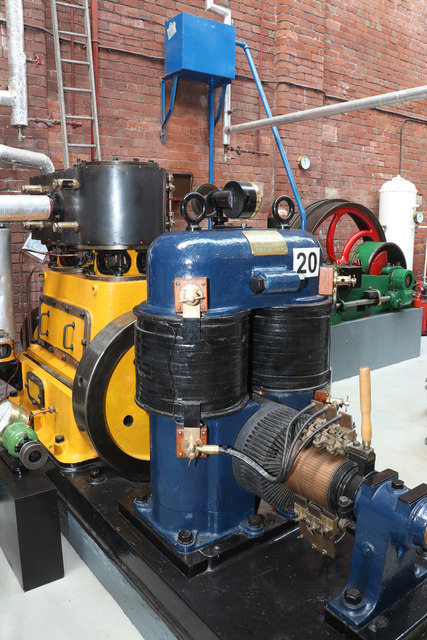Bolton Steam Museum - engine and dynamo
Introduction
The photograph on this page of Bolton Steam Museum - engine and dynamo by Chris Allen as part of the Geograph project.
The Geograph project started in 2005 with the aim of publishing, organising and preserving representative images for every square kilometre of Great Britain, Ireland and the Isle of Man.
There are currently over 7.5m images from over 14,400 individuals and you can help contribute to the project by visiting https://www.geograph.org.uk

Image: © Chris Allen Taken: 29 Dec 2018
The description below draws heavily on the Northern Mill Engine Society's website. This engine represents probably the most common type of stationary steam engine with many thousands produced over the years, some manufacturers continuing into the 1970's. A number of engines like this were still at work into the 1980's and 1990's, particularly where there was already a steam supply on site for process purposes and the engine could be used to generate electric power. The smaller sizes of engine are usually a twin cylinder inverted vertical compound layout, with a fully-enclosed crankcase and high pressure oil lubrication fed to all the journals and bearings - very much like a modern car engine. Its main advantage, however, is the speed at which engines of this type can run - 500 rpm or more was common, enabling them to be directly coupled to an electric generator without the need for belts or ropes. The engine has cylinders of 7" and 11" with a 6" stroke, running at 560 rpm, developing about 45 hp. The engine has led a varied life. It was built by Browett, Lindley Ltd in 1900 and initially supplied to Thomas Nuttall's Oak and Lakefield Mills in Farnworth, near Bolton, possibly to provide electricity for the lighting in the mills. It was subsequently acquired by the De Havilland Aircraft Co, Lostock where it was later overhauled by apprentices and presented to the Bolton Technical College as a laboratory engine. It was donated to the Society in 1967. A particularly important feature is that its original 110 volt, 250 amp dc dynamo still survives, complete with open commutator and copper gauze brushes. It is believed to have been manufactured by J A Holmes of Newcastle and is probably older than the engine - possibly 1880's

